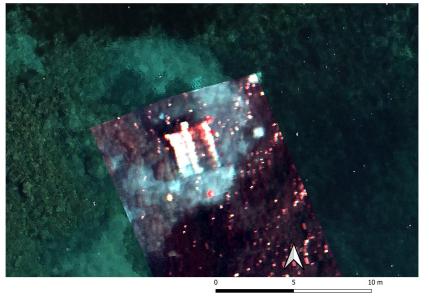SPOTS: Spectral properties of submerged and biofouled marine plastic litter

Recent studies have shown that remote sensing of floating marine plastic litter (MPL) is feasible from unmanned aerial systems, aircraft and satellite missions. However, in the infrared (IR) spectrum, water is a strong light absorber which makes the spectral detection and discrimination of plastics challenging. Additionally, MPL is often covered with living organisms and it is unclear what impact different thickness of biofouling may have on the spectral reflectance of floating plastic. In this project we further explored the relationship between depth of submersion, biofouling layer thickness and magnitude/shape of plastic’s inherent spectral reflectance. The findings of the proposed experiment can be assimilated in radiative transfer models to advance scientific knowledge relevant to the remote sensing of MPL. Furthermore, knowledge about oceanic IR absorption at different submergence depth on the spectral reflectance of MPL would be key to developing tools to estimate MPL depth and windage. The capacity to measure the submergence depth of MPL would be extremely useful for field observations because it is expected to influence long term accumulation (e.g. low windage debris with large submergence depth will more likely be captured in subtropical accumulation zones). An experiment was performed where large MPL objects were placed in tanks, with an adjustable depth of submergence. Samples of different material types, as well as samples with varying biofouling layer thickness were investigated. Each configuration was captured by a spectrometer, a hyperspectral imager, and an RGB camera. The data were analysed for key band differentials in relation to debris submergence depth and biofouling coverage.
The corresponding datasets can be found here:
https://doi.org/10.4121/769cc482-b104-4927-a94b-b16f6618c3b3
https://doi.org/10.4121/7c53b72a-be97-478b-9288-ff9c850de64b
